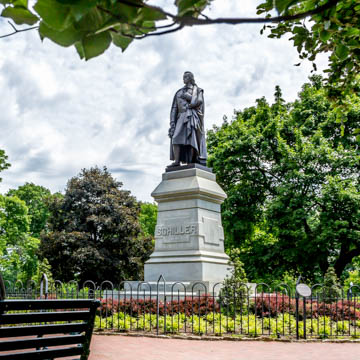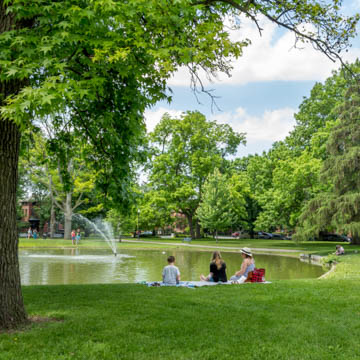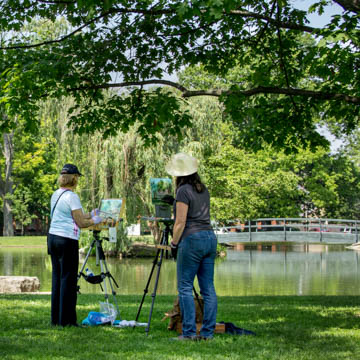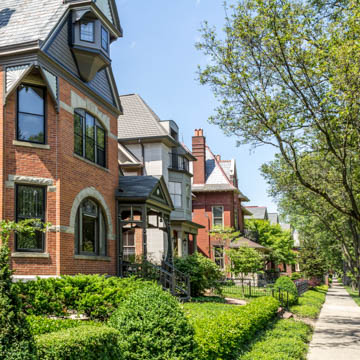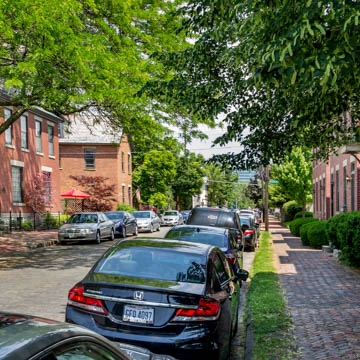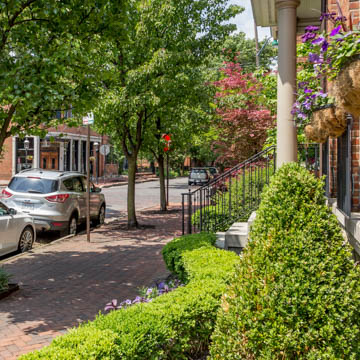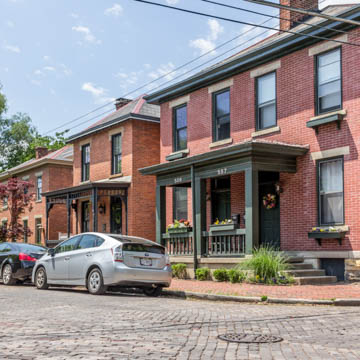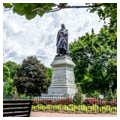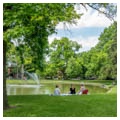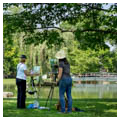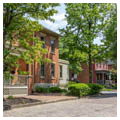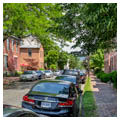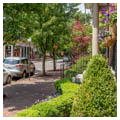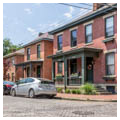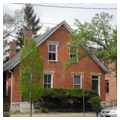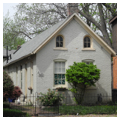German Village Historic District is a nationally recognized example of neighborhood revitalization and historic preservation. Platted in 1814, Columbus’s South End developed mainly between 1840 and 1914. German immigrants who settled the neighborhood worked as brewery workers, carpenters, tanners, bricklayers, and bakers. The dense urban fabric of the neighborhood includes commercial buildings, churches, and schools integrated among a variety of house types and styles. The nineteenth-century housing stock includes local variations of urban workers’ houses along with the Italianate and Queen Anne houses built by the owners of the breweries and other successful commercial enterprises. The most distinctive house type, and one that helps define the architectural make-up of the neighborhood, is the one-and-one-half-story, gable-roofed cottage, constructed of brick or frame with a limestone foundation. Known locally as a “Dutch-Double,” these cottages were erected from the 1850s through the 1880s, and examples include both single-family and double versions with the gable end facing the street and a window and door or windows flanking centered paired doors. Other variations include the gable end facing the street with the doors along the side elevations and ridge end facing the street with single or double doors. The exact source of the name is unknown, but “Dutch” was a corruption of “Deutsch,” or German, that was in common usage in the U.S. in the nineteenth century.
The neighborhood flourished into the twentieth century, but during World War I, German immigrants began to feel unwelcome in Columbus, and as anti-German sentiment grew stronger the neighborhood experienced German book burnings, closure of German newspapers, and public bans on the German language that included renaming roads and public places. In the southern part of the neighborhood, for example, Schiller Park was temporarily renamed Washington Park. During the 1920s, things did not improve for the neighborhood because of Prohibition, which produced unemployment among German immigrants who had worked for the breweries. As a result, many immigrants left Columbus in search of work outside the city. Compounding the impact of job loss were zoning regulations the city enacted in 1923. The whole of the South End was zoned for manufacturing and commercial use, leading to continued decline of the area’s residential blocks, notably in what would become German Village.
By the 1950s, much of the South End was derelict and many of the structures were condemned by the city. Columbus adopted the bulldoze-and-rebuild philosophy of urban renewal and used federal funds to level what was then the northern third of the South End between Main Street and Livingston Avenue. Concurrent with the city’s urban renewal scheme, however, there emerged a neighborhood preservation movement led by Frank Fetch, a city employee. Fetch purchased his first property in the South End in 1949, convinced that the neighborhood could once again become a thriving residential area. Others soon followed Fetch’s lead, and purchased and restored the neighborhood’s houses.
To prevent further demolition, in 1960 neighborhood activists created the German Village Society dedicated to promoting the preservation and rehabilitation of the area. That same year, the city officially recognized these historic preservation activities and renamed the area German Village. The city also established the German Village Commission as an advisory body to study neighborhood needs and recommend legislation to enhance the area’s preservation. Together, the German Village Society and the German Village Commission worked together to make a positive impact on the neighborhood.
One of the German Village Society’s first projects was to advocate for the rezoning of the neighborhood to encourage further preservation. They were successful: German Village was reclassified from manufacturing to AR-1, high-density residential, which allowed limited commercial uses, but eliminated industrial ones. By 1962, building permit records revealed that owners and investors had spent more than $1million in improvements. This, at a time when houses were being purchased for $5,000 or less, usually for cash since banks were hesitant to make loans due to the area’s uncertain future. In 1963, the Columbus City Council acted to make that future more stable, passing Chapter 3325 of the Columbus Zoning Code and creating the German Village Historic District. Accompanying the establishment of Columbus’s first historic district, the city council granted the German Village Commission the authority to review all construction projects in the district. German Village became one of the first designated historic districts in the country with architectural review. The creation of the German Village Historic District’s spurred similar preservation efforts across the state.
Since the 1960s, German Village has remained a bastion of preservation and the community has helped to ensure that not only individual structures, but the neighborhood’s entire urban fabric, including parks, brick streets, and sandstone curbs, remains intact. In 1977, the National Trust for Historic Preservation presented the German Village Society with its David E. Finley Award for Significant Achievement in Historic Preservation in the United States. The neighborhood has been named an American Planning Association Top Great Neighborhood, Ohio’s first Preserve America Community, and German Village is listed on the National Register of Historic Places.
References
Clark, John. German Village Stories Behind the Bricks. Charleston, SC: Arcadia Press, The History Press, 2015.
Darbee, Jeffrey T., and Nancy Recchie. The AIA Guide to Columbus.Athens: Ohio University Press, 2008.
Hunter, Bob. A Historical Guidebook to Old Columbus.Athens: Ohio University Press, 2012.
Klimoski, Gretchen, “German Village,” Franklin County, Ohio. National Register of Historic Places Inventory–Nomination, 1974. National Park Service, U.S. Department of the Interior, Washington, D.C.














